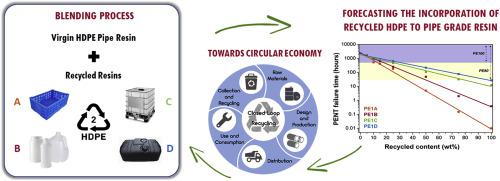Journal of Cleaner Production ( IF 9.7 ) Pub Date : 2020-09-18 , DOI: 10.1016/j.jclepro.2020.124081 Rafael Juan , Carlos Domínguez , Nuria Robledo , Beatriz Paredes , Rafael A. García-Muñoz

|
High-density polyethylene (HDPE) is one of the most used and demanded plastic, not only for packaging, but also for construction and within this application especially for non-pressure and pressure pipes, which makes this material the most abundant in the municipal waste stream. On the basis of the Circular Economy and the sustainable life that promotes, it is important to explore new applications for recycled HDPE (rHDPE) to increase the polymer recycled uptake. However, recycled HDPE is not currently being used in pressure pipes, mainly due to the high structural and loading requirements that must be met. The present study evaluates the potential use of post-consumer rHDPE from different origins in the manufacture of polyethylene pressure pipes. Different rHDPE sources are blended in different ratios with raw HDPE with PE100 grade quality. Blends are fully characterized to determine their feasibility to be used for pipe applications. Properties such as tensile strength at yield, elongation at break and flexural modulus for all blends yield values above the minimum required for PE100 grades. Furthermore, two important mechanical properties of polyethylene pipes, Slow Crack Growth (SCG) and Rapid Crack Propagation (RCP) resistances, are deeply evaluated. Remarkably, a dual correlation of SCG and RCP with the content of recycled PE in blends was established, allowing to develop predictive capabilities that guarantee the requirements and specifications for pressure pipe applications. Finally, through the evaluation of different waste streams, it can be concluded that handling, sorting, separation and selection of polyethylene’s waste is critical to achieve the required pipe specifications, and to increase the percentage of post-consumer rHDPE into the final product. This investigation is in line with the sustainability objective and the commitment to boost the circular economy by replacing part of the conventional HDPE raw material with recycled HDPE to increase close-loop recycling on PE for pipe application, and the basis for the recycling of rHDPE from pipe at its end-life, after 50 years in service.
中文翻译:

将可回收的高密度聚乙烯掺入聚乙烯管材级树脂中,以提高闭环回收率并增强循环经济
高密度聚乙烯(HDPE)是最常用和最需要的塑料之一,不仅用于包装,还用于建筑,在此应用中,尤其是非压力和压力管道,这使得这种材料在城市垃圾中含量最高流。在循环经济和促进可持续发展的基础上,重要的是探索再生HDPE(rHDPE)的新应用,以增加聚合物的再生吸收。但是,再生HDPE当前未用于压力管道,这主要是由于必须满足较高的结构和载荷要求。本研究评估了聚乙烯压力管制造中不同来源的消费后rHDPE的潜在用途。将不同的rHDPE源以不同比例与具有PE100级质量的原始HDPE混合。共混物经过充分表征,以确定其在管道应用中的可行性。所有共混物的性能,如屈服拉伸强度,断裂伸长率和挠曲模量,其屈服值均高于PE100级所要求的最小值。此外,对聚乙烯管材的两个重要机械性能,即慢速裂纹扩展(SCG)和快速裂纹扩展(RCP)阻力进行了深入评估。值得注意的是,建立了SCG和RCP与混合物中再生PE含量的双重相关性,从而可以开发预测能力,从而保证压力管道应用的要求和规格。最后,通过评估不同的废物流,可以得出以下结论:处理,分类,聚乙烯废料的分离和选择对于达到所需的管道规格以及增加消费后的rHDPE进入最终产品的百分比至关重要。此项调查符合可持续发展目标,并通过用回收的HDPE代替部分传统的HDPE原料以增加用于管道的PE的闭环回收利用,以及循环利用rHDPE的基础,从而促进了循环经济的承诺。在使用50年后,其使用寿命达到极限。











































 京公网安备 11010802027423号
京公网安备 11010802027423号